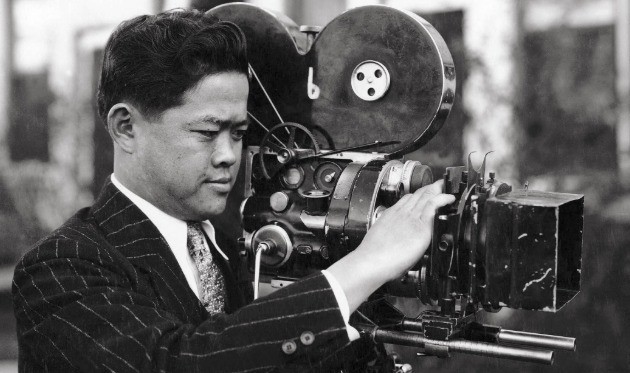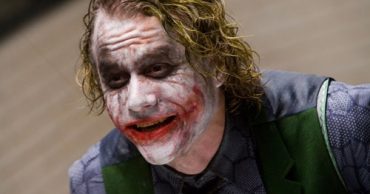
Sometimes it feels necessary to sit back and ponder just how what seems so commonplace in Hollywood came to be, and how the movie industry was revolutionized by those that came before and found new ways to film and new techniques to use. This is when you find out more about individuals such as James Wong Howe and the things they’ve done in their lives. While he wasn’t initially even allowed near a camera for a number of reasons he was tenacious enough to keep pushing and pushing until finally it was discovered that he had a real talent that was innate in some ways and learned in others. From the moment that his talent was discovered he still had to work hard in order to and continue to learn what he could in order to keep his skills on the cutting edge of what was needed in order to keep him in the game.
Here are a few things you might not know about him.
1. His father settled in Pasco, Washington in 1899.
This was the same year that James was born and he would join his father five years later. A lot of people from other countries made their way to America throughout the country’s infancy and later years, seeking to find prosperity in a new place that was filled with opportunity.
2. There was a great deal of discrimination to be faced during this time.
Around this time in America people were severely intolerant of foreigners, which was kind of odd as well as amusing considering how the nation was founded, and that those that had been there for only a few generations or less were still considered as close to foreigners as could be. The difference was that many Europeans were so similar in appearance that they were widely accepted.
3. Initially he wanted to be a prizefighter.
Prizefighting was amazingly lucrative at this time despite the fact that it took a fighter a great deal of pain to become known as a capable fighter. James eventually grew tired of this idea and came up with other ideas on how to spend his time.
4. He had a job assisting a commercial photographer at one time.
This could have been his ticket to the job he was starting to want, but he got fired after it was discovered that he was doing favors for a friend in the dark room that the photographer didn’t appreciate, such as creating passport photos.
5. Eventually he was made a janitor at a film studio since he was considered too small for manual labor.
This was a much more hazardous job than it seemed since he had to clean up old film clippings, which were made from a material at that time that was highly flammable. Fires were fairly common in that time thanks to this fact.
6. In time he moved up to the position of slate boy.
That’s no joke. Remember seeing the people that hold the markers that would be used to help start the scene? In his day these were still slate boards that had to be written on. In fact these were used for some time and still are in some cases, but a lot of them are digital now.
7. Once it was discovered that he had a talent for camera work he started to rise gradually in the ranks.
James began to climb the ranks by showing several different techniques that were used to improve the quality of the shot in various ways. This knowledge and practice began to endear him to those that had initially thought little of him.
8. He was in high demand at one point for his techniques since they helped to revolutionize the film industry.
James became well known for his contributions and was something of a star behind the scenes since whenever he was around people would attempt to gain his help on this or that matter that needed tweaking. He was quite popular for a while since he knew what he was doing and had come to employ techniques that were highly sought after.
9. Howe admired Humphrey Bogart for his honesty.
He was heard to say that 99 percent of those in Hollywood would almost never say what they meant and would dance around any issue or discussion as much as possible in order to avoid saying anything wrong or in any way damaging. Bogart apparently laid it all out for people and didn’t mince words, deciding to tell people how it was without giving much care as to whether it offended them or not.
10. His take on Greta Garbo was kind of interesting.
James likened her to a race horse, as in she didn’t do much before that opening bell rang, at which point she would become all action and all energy and vibe. It’s an interesting analogy to ascribe to someone but still very accurate in some cases.
11. Born in Guangzhou
Wong was born in Guangzhou, which is the capital of Guangdong province in China. This isn’t surprising because most of the Chinese people who emigrated overseas before the second half of the 20th century came from one of two Chinese provinces, with one being Guangdong and the other being Fujian. Most of the Guangdong emigrants winded up in the western hemisphere, while most of the Fujian emigrants winded up in Southeast Asia.
12. Got a Break When Photographing Mary Miles Minter
When he was still a camera assistant, one of Wong’s responsibilities was photographing the stars for promotional purposes. One of the moments that enabled him to make a transition to cinematographer was when he discovered a way to make Mary Miles Minter’s eyes look darker in the photographs by having her look at a dark surface. As a result, Minter asked that Wong be the first cameraman on her next movie.
13. Got Caught Flat-Footed By the Talkies
Like a lot of people who had become successful because of silent movies, Wong was caught flat-footed when the “talkies” overtook their predecessors in popularity. In his case, he was shooting backgrounds in China for a movie that never got made when the transition happened, meaning that the change in circumstances must’ve been quite a shock when he returned to the United States.
14. Had to Reestablish Himself for the Talkies
With that said, Wong was fortunate in that he was able to reestablish himself as a cinematographer of note, though this was neither a smooth nor an uncomplicated process. For proof, look no further than the fact that he had to co-finance a Japanese language movie that failed and then shoot a second movie for no salary before an acquaintance hired him for The Criminal Code.
15. Developed a Reputation for Perfectionism
Over the course of his career, Wong built up a reputation for perfectionism. On the one hand, this meant that he was a very hard worker, as shown by how he would work on multiple movies on an annual basis throughout the 1930s and 1940s. On the other hand, this meant that he had very high expectations for other people, which could cause him to berate other crew members when he felt that their work was lacking in some manner.
16. Had to Get Married in France
Wong got married to the novelist, poet, and literary editor Sanora Babb in 1937. However, the two had to do so in Paris because of laws in the United States that banned interracial marriage.
17. Couldn’t Acknowledge His Marriage
It wasn’t until 1948 that Wong and Babb’s marriage was recognized by the state of California because of the abolishing of the laws that banned interracial marriage in the United States. Until then, the moral clause in Wong’s contracts meant that he couldn’t acknowledge his marriage with Babb.
18. Got Gray-Listed
The Hollywood blacklist was the denial of employment to dozens and dozens of American entertainment professionals in the middle of the 20th century because they were accused of having either Communist ties or Communist sympathies. The graylist is a subset of the blacklist that referred to people who were denied employment because of their political or personal affiliations as well as people who couldn’t get work with the major studios but could still get work with the small B movie studios on Poverty Row. Wong wasn’t a Communist, but he was named as a Communist sympathizer by others, which presumably wasn’t helped by the fact that his wife had been a member of the US Communist Party until she was disillusioned by both its infighting and its authoritarian structure.
19. Raised His Godson
When his godson came to the United States, Wong became the one who raised him. It is interesting to note that said godson Martin Fong became a somewhat famous figure in the entertainment industry in his own right, seeing as how he was one of the first Chinese-American tap dancers to dance on the Las Vegas Strip. Besides that, Fong was a cinematographer as well because of Wong’s mentorship.
20. Ten Oscar Nominations
In total, Wong was nominated for the Oscar for Best Cinematography ten times. Moreover, he managed to win twice, with one in 1955 for The Rose Tattoo and the other in 1963 for Hud.
 Follow Us
Follow Us






Great article about my great-uncle James Wong Howe. However, by my count, he was nominated for 16 Academy Awards, not just 10.
Thanks for your response, I do apologize for the misinformation. That’s insanely impressive. It’s been 3 years since I wrote this and I’ll be honest I forgot about it. But I very much appreciate your feedback. Again, I am sorry about the error in his number of nominations, I’ll own that mistake. Take care.